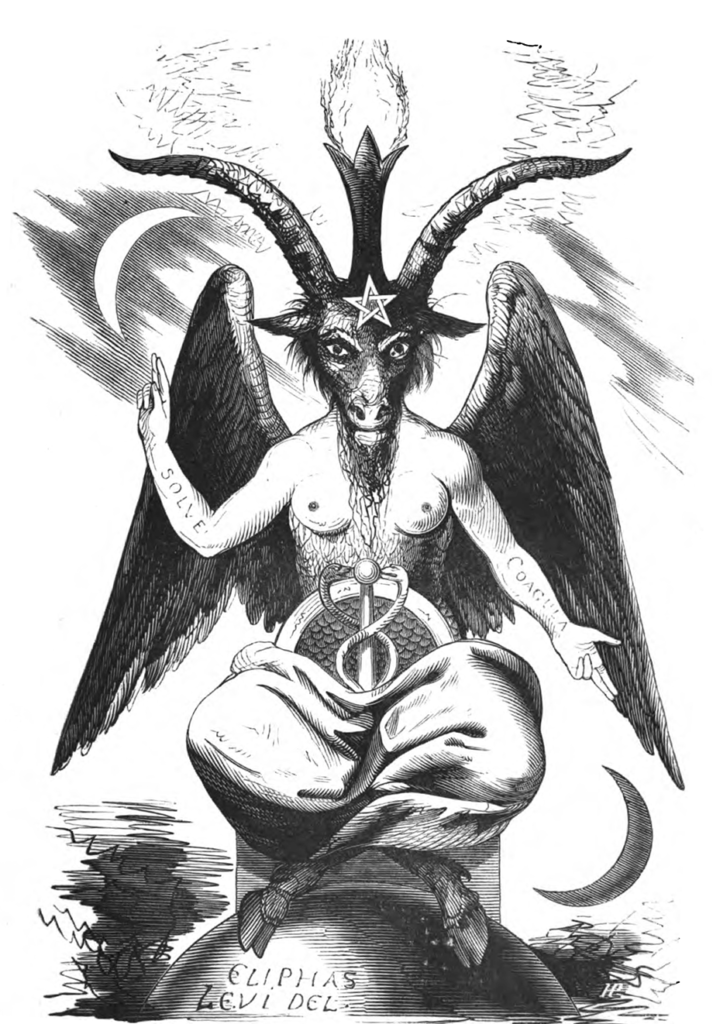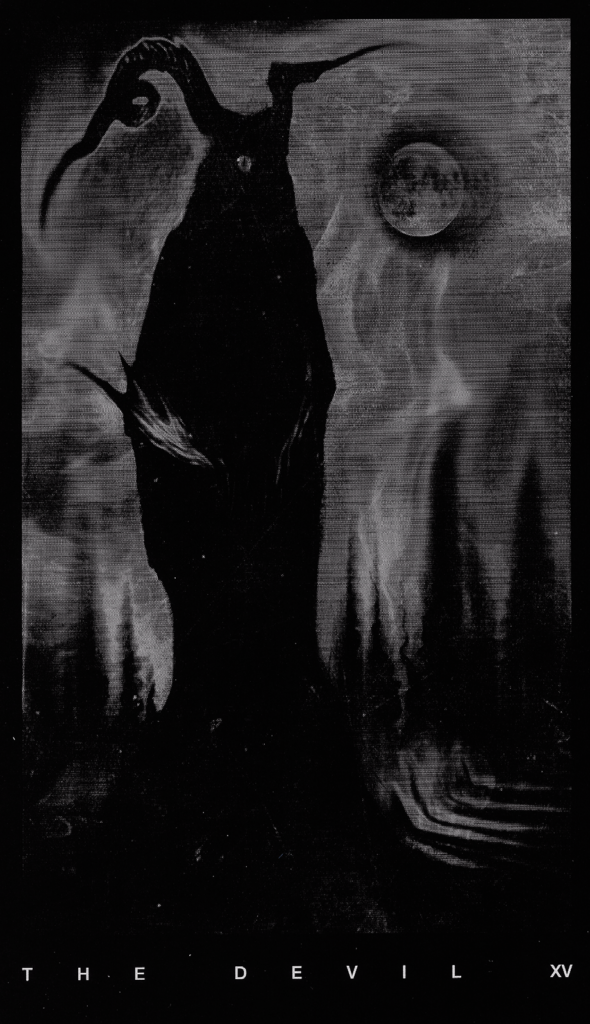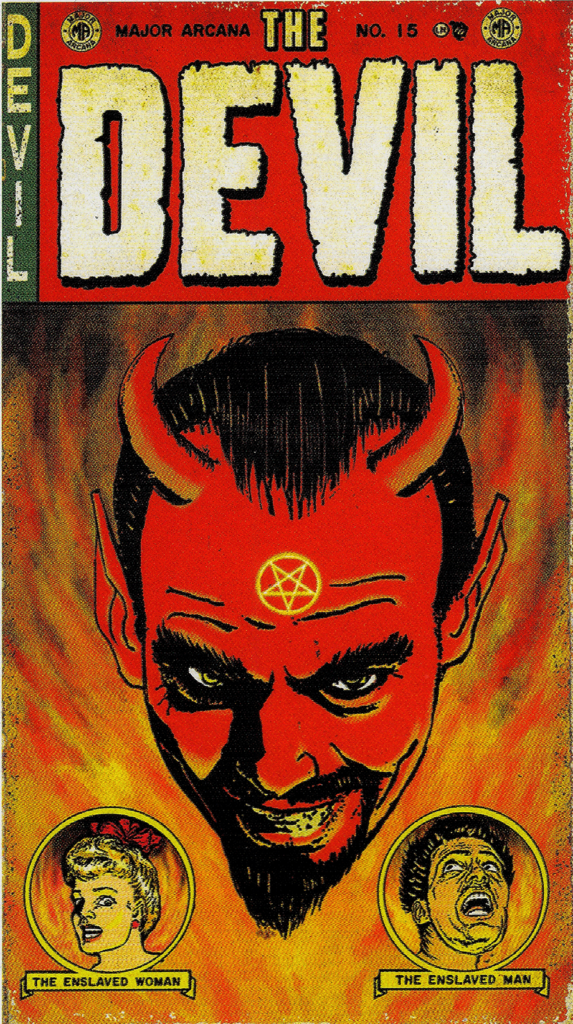The Devil hath power to assume a pleasing shape.
Hamlet: Act II, Scene 2 – William Shakespeare
Starting with the Hanged Man at XII we have been delving into cards that, at face value, purport ill-tidings. Even last week’s Temperance is couched in the same gloomy sky that Death shares, and that tells us that we are in places where mortals fear to tread.
Number XV is called the Devil. As noted in some of the earlier articles, this card’s layout seems a parody of the Lovers card at VI, and there is a good reason for that. As depicted in the Rider-Waite-Smith Deck, the Devil is a red and orange demon, with a feline head, large bat-like ears, gray ram’s horns, great bat wings, and a shaggy lower torso and legs ending in taloned feet. In his left hand he hold inverted a large torch. His right hand is lifted and is positioned with the thumb out, and the two fingers on either side together, forming a v-shape in the middle. The Devil is perched on a black block to which is affixed a large iron ring. On either side of the this ring a chain is attached, and the chains are secured to an iron collar around the neck of a male and female being. These are very similar to the male and female depicted in Eden in the Lovers, but on closer view, the woman has horns and a tail that ends in a bunch of grapes, while the man has pointed ears and a tail that ends in a flame shape. The entire background of this card is black. Between the Devil’s horns is an inverted pentagram.

There are a number of intentional symbols included in this version of the card that derive from various sources. We can start with the basic design of the being Baphomet from Eliphas Levi. Here is a strange goat-headed god, with a center horn that blazes, an upright (by traditional reckoning) pentagram on it’s brow, with female breasts and eagle wings. From out of the robes that cover it’s lower part rises a fully erect caduceus (to prevent Victorian gentlemen from having to observe a wang other than their own, I’m sure) backed by a scaled shield (possibly the Aegis of Athena). The arms are in similar position to the one we find on the XV card, but the hand gestures are those of the common Christian blessing, on both hands. The raised right arm is inscribed “Solve” and lowered left arm “Coagula”. There are hooves at the end of the beings legs, and it sits cross-legged on a block on top of a sphere (the world?) Two crescent moons are at the tips of the fingers, a light one on the right and a darker on the left.
Baphomet was later borrowed by the Church of Satan under Anton Le Vey and has become an enduring symbol of Satanic and anti-Christian Black Magic in the popular culture. This composite being is, however, much like the alchemical chimera that we see in various depictions of the Temperance card, and represents that union of opposites, the joining of the aspects of things, to create the true shape of the thing. Despite the rather obvious societal restraints placed on displaying any sort of masculine sexuality (because that would be upsetting), Baphomet is an hermaphrodite. It is so in the same sense that the hermaphrodite appears in alchemy, not as a sexual fetish but as an allegory for the fusion of opposing powers.
The name Baphomet is borrowed from the confessions of tortured Templars who, under duress, confessed to worshiping a “head” with that name. Scholars have theorized that the word is a corruption of Mahomet, or Muhammed, the chief prophet of Islam, and that these strange crusaders had become secret Muslims during their sojourn in the Holy Land. So much is written about the Templars, and so much of it is modern fiction, that it is difficult to say one way or the other. Certainly the Templars adopted a good number of Islamic conventions, particularly regarding the handling and exchange of money. The legends suggest that this was some great fortune that has yet to be discovered (sorry, Ben Gates) but it may simply have been the use of the financial methods of their temporarily conquered enemies that made it appear so.
Levi was not the first to use the name, but he has perhaps conjured the most enduring image of it. Wikipedia would have you believe he took the Tarot devil as inspiration, and perhaps Waite thought the same, but if we glance at the Devil in the Tarot de Marseilles we see there is very little in common with either Levi’s chimera or Waite’s Devil, where there is much resemblance of those two to each other. The Marseilles Devil, and his minions are strangely attired. While the Devil itself is shown with breasts and a penis, the horns, wings and other “demonic” trappings look to be a costume. The crescent moon shaped objects on the breast might even be a kind of “wonder bra” indicating that this figure derives more from the theater than the pit. Paul Huson suggests that many of the Tarot trumps were based upon scenes depicted in the early passion plays of Medieval times, and that there origin has been obscured by history. If he is correct, and this seems reasonable, then the Devil here is meant to be mocked and ridiculed. It’s outrageous appearance is a Medieval fantasy of the church, and popular superstition.

Prior to his invention, devils more usually resembled the composite nightmare creatures that were neither fish nor fowl. Splendid examples are to be found in the painting of Hell by Heironymus Bosch, and works by his contemporaries in Northern Europe. The sensibility here was that since the Fallen Angel, lacked the power of true creation, he was forced to create his minions out of the pieces of things that God had already made.
Further south, Michelangelo’s hellish hoards are less imaginative, consisting of grey and green brutes with long ears and snouts. This may not be so much of a cultural difference as a need to complete a large number of large figures in a short time. Bosch’s demonic world is all part of a small altarpiece, whereas the Last Judgment figures are larger than life. The composite beast version of his Satanic Majesty won out in the designs of the early Tarocchi.
Levi was creating a metaphor, in the good old alchemical tradition, for what he considered to be an ancient pagan ideology. The figure of Baphomet, along with the other diabolical names he cites in his works, was representative of a more ancient deity or deities that were secretly worshipped by closet polytheists. He was Pan, the great goat, the old fertility god. And of course, he is also Khmnu the creator god symbolized by the ram, and confounded with Amun in the Egyptian myths. But the Devil of the Tarot is, historically speaking, that Christian principle of the infernal, the Fallen Angel, the King of Hell, and therefore can’t really be seen as either ancient pagan avatar or modern magical symbolism.
The Visconti Sforza deck doesn’t assist us in unraveling this puzzle, because the Devil card is one of those replaced later by another artist. It is therefore difficult to say what form the original had, if any. There is speculation that many early Devil cards were used as a surrogate for the being itself, either by sorcerers seeking to curry it’s favor, or churchmen looking for a whipping boy in various rituals. So the number of such cards from the earlier decks are rare, and the best we may expect is what is depicted with Marseilles, an actor in a kind of Halloween costume, whose role was to meet and be defeated by the slain Christ in one of the apocryphal resurrection stories. This tale becomes more relevant to the history of the Tower card, so I will only mention it here, but it is derived from the musings of the early Christian fathers and seems to connect up a number of these middle Major Arcana Cards.
Baphomet would appear to have suffered a major railway accident on his way to the RWS deck. His nethers have now been tastefully covered with fur, preventing any homoerotic suggestions from polluting the practitioners’ minds. One might, if one looked at the swirling hairs, glean just perhaps a suggestion of an erect member, but of course that might simply be a Freudian illusion. The breasts are gone now, too. There’s no fusion of genders going on here. Old Scratch is unquestionably male.
The central flaming horn equated with Lucifer – the Light Bringer is now turned downward. This signifies the perversion of the Light of Truth, that the Devil brings only deceit and illusion. Curiously I have seen Hekate’s torch similarly depicted in art, though I believe these are all modern glosses and may have been influenced by Card XV in this deck. Likewise we have inverted the pentagram. The original is Aristotelean. That is, it derives from the writings of Aristotle, in describing the five elements – Earth, Air, Fire, Water, and Quintessence, which in modern terms is called Spirit. Spirit was what we might determine as anima in Aristotle’s mind. It was that substance that made something alive, which could not be accomplished by combinations of the other four elements alone. Thus pentagram then, is an emblem of this, with Spirit at the apex, the most sublime and dominant of the other elements. By inversion on the Devil’s brow, we connote his overturning of the natural order. The Devil was antithesis of God, and in all ways then opposite and backward. Dante’s Inferno has him turned upside down, where he plunged into the Earth at the time of the Fall. Spirit is now at the bottom, with the material components of the world arrayed above it. This signifies an obsession with the material, with the worldly, over the spiritual, that is connected to the idea of sin and punishment.
We find bat wings on the Marseilles Devil, and on many many depictions of demons and devils in art. Bats are creatures of the night. They shun the light. They are not birds but they fly. Thus these easily become contrary symbols and are more suitable to an infernal and oppositional being than Baphomet’s feathered pinions. The other alterations in his visage are in keeping with the Gothic style that Pamela Smith mimics in her designs for the Tarot.

This image kept reminding me of something else, and I couldn’t quite place it until this morning. It brings to mind the Devil card of H. R. Giger, or at least the image was presented as the Devil card. Unfortunately I did not have time to scan that card before press time. There is some similarity in the single eye and the horn, but I can’t say with any certainty that this Devil was inspired by the Giger one. Giger’s version is very socially critical, as was much of his work outside the popularly known, and merits discussion on it’s own at some later point.
Something must be said of the upraised hand’s similarity to the gesture of a famous character in an old science fiction franchise. The so-called “Vulcan salute” associated with Star Trek’s Mr. Spock, is, in fact, the same as that being made by this character. They both derive from the same source. Leonard Nimoy, the actor who created much of the Spock character, was the child of immigrant Russian Jews. He based the gesture on something he saw as a child in the synagogue, when the rabbis were blessing the congregation. They put forth their hands in the shape of the letter Shin, which forms the start of the word Shem HaMeforash, a term denoting the all mighty, or the sacred name of Adonai/Elohim/Yawveh.
So while Baphomet is using the “proper” Catholic hand gesture for blessing (never mind that it’s also a Hindu mudra), in an astonishingly blatant display of anti-Semitism, the Devil is pronouncing a Hebrew blessing. It’s very hard to reconcile this with the fascination that many of the lodge magicians (Waite included) had with Hebrew “secrets” and Kabbala, but there seems to be no other good explanation for this. The lodge magicians, despite their “rediscovered” paganism, were still essentially enmired in that long Christian attitude that the Jews, in denying the divinity of Jesus, were a sinful people, worthy of scorn, and deserving of the various persecutions and disasters visited upon them. We have hopefully moved away from such horrendous ideas, but it is necessary to understand this atmosphere was very different during the construction of the RWS Tarot. Since this deck has had such a strong influence, it is important to look at the negative ideas that are part of it’s baggage, and perhaps, evolve a kinder and more enlightened awareness of the messages we are receiving through it. Particularly when writers, including Waite, expound upon the “moral lesson” inherent in this card.
The moral lesson is the need to reject that material obsession in favor of our spiritual freedom. That this is a mockery of the scene in Eden before the Fall is intentional. Rather than exulting in the beautiful garden under the protection of the Bright Angel, here humanity is chained to the slave block, owned by their bad habits, symbolized by the drunkenness of the body (Eve’s tail) and the lustfulness of the passions (Adam’s tail). The minions of the Dark One live by the motto “If it feels good, do it!” never realizing that all they are experiencing is the mere illusion of temporary pleasure. Pursuing lives of sensation and emotion, they are never free to explore the higher mind that dwells within.
There’s obviously a Judeo-Christian bent to this idea, but we can find the same idea in the Eastern beliefs. Suffering is the result of longing for that which is temporary. It is not the real world, but an illusion. The real world is permanent, inviolable, and without division. The illusionary world is one of constant loss, change, and desire. Only by denying the desire can are we able to see past the illusion.
There are several flavors of Satanism in the world today. One of the variants is that what people call “God” is actually the creator and ruler of this illusionary world. Satan, then, in opposing that “God” is trying to free humankind from the illusion, and show them the way things really are. I don’t ascribe to this personally, but I think it’s an interesting area to explore, especially in relation to resolving the Devil card. The old Hebrew word Shaitan whence comes the modern Satan simply means “adversary” In some contexts, it is more correct to view Shaitan as an externalization of the divine mind, created for the purpose of presenting an alternate, or opposing view. That is, the Rebel Angel fulfills the need for God to have someone tell him he’s wrong.

Is is just me or does he look like Nicolas Cage?
So when the Infernal Prince hops up in a card reading, the message may not be a super spiritual one, or warning about the wages of sin. It may simply mean that you need to stop believing your own press. Everything one this card is about the reversal of what is “true, just and correct”. So it stands to reason that it portends situations that are illusory, particularly those which involve self-deception, and the tendency to believe what we hope is true, despite much evidence to the contrary. It is an emblem of our willful desire to decide the world is the way we want it to be, even when it isn’t. In this respect, we are rebelling against what the universe is trying to tell us, and will reap the unpleasant result of this self-delusion. The Devil is not a creature within tempting us to this fate, it is an externalization of what we know better, but would rather not have to accept.
When next I write, we’ll be looking at the last of the dark and dreary cards, the Tower, and examine both its traditional meanings and how we may re-interpret those as a means of controlling our own destinies.
Thank you for continuing to support this series of articles. I’ll be back next week.

